Related Research Articles

The North Island Main Trunk (NIMT) is the main railway line in the North Island of New Zealand, connecting the capital city Wellington with the country's largest city, Auckland. The line is 682 kilometres (424 mi) long, built to the New Zealand rail gauge of 1,067 mm and serves the large cities of Palmerston North and Hamilton.
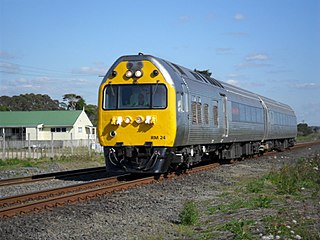
The NZR RM class Silver Fern was a class of rail motor in New Zealand. The three air-conditioned and sound-proofed 723-kW 96-seater diesel-electric twin-set railcars were built by Kawasaki under contract with Nissho Iwai of Japan. New Zealand Railways (NZR) classified the railcars as RM (Rail Motor), the same as other railcars, using the Silver Ferns (a national symbol of New Zealand) because of their exterior was made of corrugated stainless steel, like the premier night sleeper train that also ran on the Wellington-Auckland (North Island Main Trunk) route, the Silver Star. The Silver Ferns replaced the three successful Blue Streak railcars on the service.
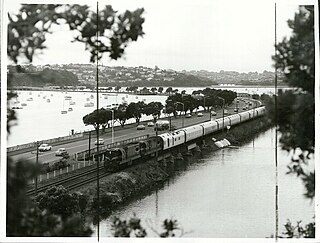
The Silver Star was a luxury passenger train that ran overnight between Auckland and Wellington on the North Island Main Trunk (NIMT) railway of New Zealand, operated by New Zealand Railways (NZR). The train ran from Monday 6 September 1971 until Sunday 8 June 1979. It replaced the Night Limited express passenger trains which provided a faster service than the ordinary express trains, by stopping at only six intermediate stations en route and not hauling a postal (sorting) van as on previous trains.

The NZR JA class was a class of fifty-one 4-8-2 steam locomotives operated by the New Zealand Railways Department (NZR). The locomotives were built in two batches; the first batch was constructed in-home at the Hillside Workshops at Dunedin between 1946 and 1956, while the second batch was produced by the North British Locomotive Company (NBL) of Glasgow, Scotland in 1951. To differentiate between the two batches, the locomotives were identified by their builder.

The NZR KA class of 1939 was a class of mixed traffic 4-8-4 steam locomotives that operated on New Zealand's railway network. They were built after the success of the K class to meet the increasing traffic demands of the New Zealand Railways Department. The locomotives first appeared with distinctive streamlining, mainly to hide their ACFI feedwater heater systems.
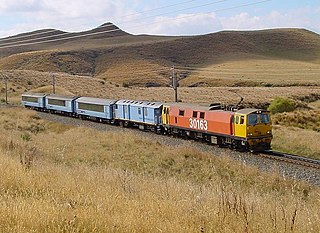
The Overlander was a long-distance rail passenger train between Auckland and Wellington in the North Island of New Zealand, along the North Island Main Trunk (NIMT). It was operated by Tranz Scenic. The service was replaced from 25 June 2012, by the Northern Explorer.
The Northerner was an overnight passenger train between Wellington and Auckland in New Zealand. The train replaced the unnamed and ordinary express trains supplementing the luxury Silver Star, which had replaced the Night Limited in 1971. The Northerner operated from 1975 to 2004.
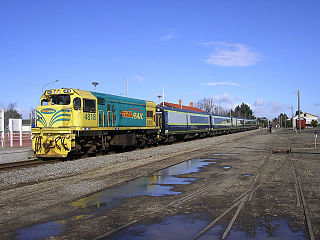
The Wairarapa Connection is a New Zealand interurban commuter rail service along the Wairarapa Line between Masterton, the largest town in the Wairarapa, and Wellington. It is operated by Wellington suburban operator Transdev under contract from the Greater Wellington Regional Council. It is a diesel-hauled carriage service, introduced by the New Zealand Railways Department in 1964 after passenger demand between Masterton to Wellington exceeded the capacity of the diesel railcars then used.
The Night Limited was an express passenger train that operated in New Zealand between Wellington and Auckland, utilising the entire length of the North Island Main Trunk. It commenced service on 15 December 1924 and was replaced by the Silver Star in 1971 and supplemented by the Northerner express in 1975.
The Scenic Daylight was a daytime express train in New Zealand, introduced on 17 December 1960 between Auckland and Wellington along the North Island Main Trunk Railway, replacing the Daylight Limited. The service was steam-hauled initially but from 1963 it was diesel-hauled. The service was itself replaced in 1968 by the Blue Streak railcar service.

The NZR RM class Sentinel-Cammell was a steam-powered railcar operated by the New Zealand Railways Department (NZR). It was the only one of its type to operate in New Zealand, and one of only two steam railcars trialled in the country; the other was the Clayton steam railcar.
The Rotorua Express was a passenger express train operated by the New Zealand Railways Department between Auckland and Rotorua. It operated from 1894 until 1959 and was known as the Rotorua Limited between 1930 and 1937. This train was one of the first expresses in the world to use Pacific (4-6-2) type locomotives.
The Thames Express was an express passenger train operated by the New Zealand Railways Department between Auckland and Thames. It ran between 1908 and 1928.

The New Plymouth Express was a passenger express train operated by the New Zealand Railways Department (NZR) between Wellington and New Plymouth. It ran from 1886 until 1955 and was sometimes known as the New Plymouth Mail due to the Railway Travelling Post Office carriages included in its consist. The Express was notable amongst NZR's provincial expresses as being both the first and, until the commencement of the Gisborne Express in 1942, the longest in distance travelled.
The New Plymouth Night Express was a passenger express train operated by the New Zealand Railways Department (NZR) that ran between Auckland and New Plymouth. It ran in various forms from 1933 until 1983, though the Express designation was lost in 1956 and later incarnations did not operate at night and terminated in Taumarunui rather than Auckland. The New Plymouth Night Express should not be confused with the New Plymouth Express that operated between New Plymouth and Wellington.
The Marton–New Plymouth line (MNPL) is a secondary main line railway in the North Island of New Zealand that links the Taranaki and Manawatū-Whanganui regions. It branches from the North Island Main Trunk railway (NIMT) at Marton and runs near the South Taranaki Bight of the west coast before turning inland, meeting the Stratford–Okahukura Line (SOL) at Stratford and running to New Plymouth. Construction of the line was completed in 1885, and along with the SOL it provided an alternate route to the NIMT from the SOL's completion in 1933 until the latter was mothballed in 2010. In its early days it was plied by the North Island's first regional express, the New Plymouth Express, but it has been freight only since the cancellation of the last passenger services in 1977.
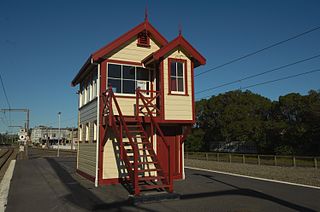
Paekakariki railway station in Paekākāriki on the Kāpiti Coast, New Zealand, is an intermediate station on the Kapiti Line for Metlink's electric multiple unit commuter trains from Wellington. Paekākāriki was the terminal station of the commuter service from 1940 to 1983, when the service was extended to Paraparaumu, and to Waikanae in 2011.

The Northern Explorer is a long-distance passenger train operated by the Great Journeys New Zealand division of KiwiRail between Auckland and Wellington in the North Island of New Zealand, along the North Island Main Trunk (NIMT). Three services operate per week in each direction between Auckland's The Strand Station and Wellington railway station. The Northern Explorer replaced the Overlander from 25 June 2012.

Great Journeys New Zealand is the tourism division of KiwiRail that operate its three Scenic train services. The new division was launched in May 2017 and replaced the former tourism brand KiwiRail Scenic Journeys. It has continuity with the earlier InterCity Rail (1987–1995) and Tranz Scenic (1995–2011).
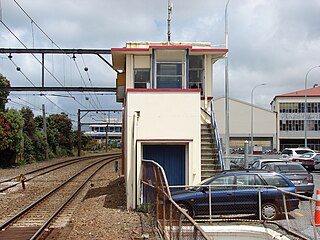
The first railway line in New Zealand was the line from Christchurch to Ferrymead opened in 1863. Under the “Grand Go-ahead Policy” of public works instituted by Sir Julius Vogel in 1870 the network was rapidly expanded. Initially lines went from the main town and port to the rural hinterland, but the line between the cities of Christchurch and Dunedin section of the South Island Main Trunk Railway opened in 1878. The New Zealand Railways Department was established in 1876, and the rail network was then run by the central government rather than by provincial governments. Signalling installation was handled by district engineers in the maintenance branch. The Rakaia rail accident in 1899 when four passengers were killed showed the deficiencies in railway signalling and braking; Rakaia did not have fixed signals, and rolling stock apart from locomotives did not have air brakes. But those lines with heavier traffic already had block working installed. The first signalling and interlocking engineer had already been appointed in 1899 at a salary of £400; Arthur H. Johnson, who had “considerable experience in England and America” and who was to design and develop a uniform system of interlocking points and signals. <!—NZ Herald 23 May 1898 --> But he resigned in 1899, and returned to England c1901. He was replaced by Henry John Wynne from 1900; with staff of a chief signal inspector in Wellington and several regional signal inspectors. Wynne retired in 1929. Wynne was replaced by Guy Wilfred Wyles (1887-1947) as Signalling and electrical engineer. Wyles had started with Sykes Interlocking Co in London. He married into Wynn’s family, and died of peritonitis three months before his retirement. The first three engineers all trained in England. Signalling in New Zealand was based on British practice for 60 years until about 1922, when it became “essentially indigenous” – partly British with two-aspect mechanical signalling and partly American with automatic three-aspect signalling using so-called ‘”speed’ indicators.